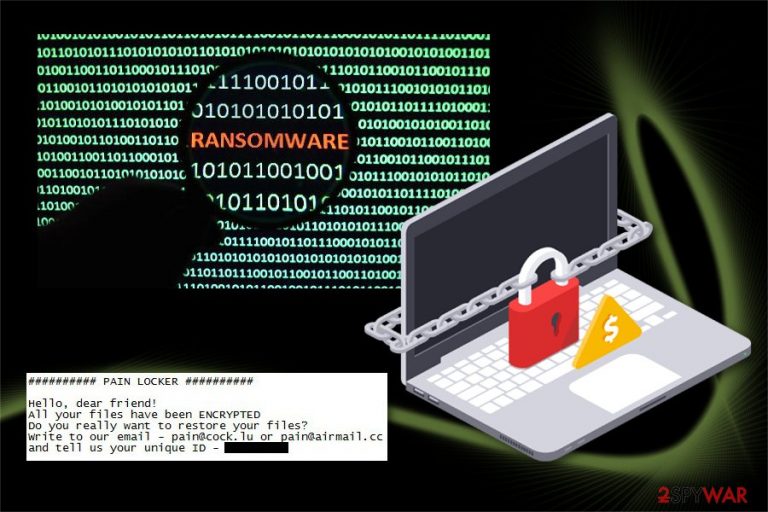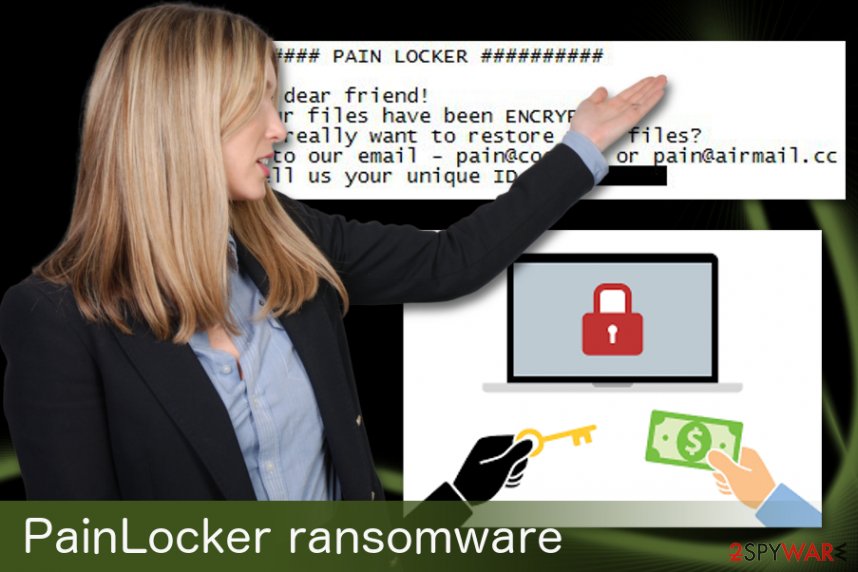PainLocker ransomware (Removal Instructions) - Recovery Instructions Included
PainLocker virus Removal Guide
What is PainLocker ransomware?
PainLocker virus is a ransomware that demands payment in cryptocurrency for file decryption

PainLocker is the newest version of Everbe cryptovirus. It appends [pain@cock.lu].pain file extension to the targeted audio, video, image, documents, and other important files. Then it downloads a data recovery instructions in !=How_recovery_files=!.txt. Authors of the ransomware[1] follow the same manner – victims are asked to contact them and pay a set amount of money.
| Summary | |
|---|---|
| Name | PainLocker |
| Type | Ransomware |
| Family | Everbe ransomware |
| Extension | [pain@cock.lu].pain |
| Contact email address | pain@cock.lu |
| Ransom note | !=How_recovery_files=!.txt |
| Decryption | Free decryption tool is not created yet |
| Symptoms | Suspicious file extension added to files, computer errors, sluggish performance, appearance of unknown programs or files |
| To uninstall PainLocker, install FortectIntego and run a full system scan | |
After the infiltration, the PainLocker virus examines stored files and encrypts all the most used and important ones placing specific extension. These files can be anything and everything from text files, documents to photos and videos. Encryption makes data useless, and these files can be recovered only with individual key r replaced from an external backup.
If you haven’t backed up your files, you might be interested in obtaining a specific decryption key. Cyber criminals, who own it, explain how victims can get it in the ransom-demanding message written in “!=How_recovery_files=!.txt’’ file PainLocker ransomware demands payment in cryptocurrency and contacting them via email ( pain@cock.lu or pain@airmail.cc).
Hello, dear friend!
All your files have been ENCRYPTED
Do you really want to restore your files?
Write to our email – pain@coc.lu or pain@airmail.cc
and tell us your unique ID – [redacted]
Malware researchers from LosVirus.es[2] report that contacting crooks and paying a ransom should be avoided. They can ignore you and disappear after the payment is made. No matter how much you value your files, you should remove PainLocker as soon as you find it on the computer.
PainLocker removal requires using anti-malware software. We recommend using FortectIntego which not only deletes malicious components but can fix all the damage caused by ransomware. This cyber threat makes various system changes that can cause computer-related problems in the future too.

Malicious spam emails are the main ransomware distribution method
Spam emails can be the ones containing advertisement, deals, offers and sales from never before seen companies, often from unknown addresses in other languages. Spam email box often is filled with newsletters and commercial information. Clean that box more often without opening any letters to avoid encountering ransomware.
You should never open any spam email from suspicious addresses, especially attachments. Those attachments may contain trojans or other viruses with suspicious activity. You should also keep your tools and software up-to-date and anti-spyware programs running correctly.
However, some of these letters can seem legitimate and send from the popular organizations, such as FedEx or Amazon. Therefore, it might be tricky to recognize phishing email.[3] However, if you do not use the services or you are not supposed to get a parcel, ignore those shady emails.
Eliminate PainLocker ransomware from Windows OS
PainLocker removal is crucial and has to be done properly. It means that you have to obtain a reputable security software and run a full system scan. We suggest using tools like FortectIntego, SpyHunter 5Combo Cleaner or Malwarebytes. Only after the cleaning and double-checking that your system is safe again, you can restore those files from a backup.
However, if you do not have your files stored on external or cloud drive, you can try using third-party data recovery options. We have explained them below. However, you have to remove PainLocker first!
Getting rid of PainLocker virus. Follow these steps
Manual removal using Safe Mode
If you cannot open or run security software for PainLocker ransomware removal, follow this guide:
Important! →
Manual removal guide might be too complicated for regular computer users. It requires advanced IT knowledge to be performed correctly (if vital system files are removed or damaged, it might result in full Windows compromise), and it also might take hours to complete. Therefore, we highly advise using the automatic method provided above instead.
Step 1. Access Safe Mode with Networking
Manual malware removal should be best performed in the Safe Mode environment.
Windows 7 / Vista / XP
- Click Start > Shutdown > Restart > OK.
- When your computer becomes active, start pressing F8 button (if that does not work, try F2, F12, Del, etc. – it all depends on your motherboard model) multiple times until you see the Advanced Boot Options window.
- Select Safe Mode with Networking from the list.

Windows 10 / Windows 8
- Right-click on Start button and select Settings.

- Scroll down to pick Update & Security.

- On the left side of the window, pick Recovery.
- Now scroll down to find Advanced Startup section.
- Click Restart now.

- Select Troubleshoot.

- Go to Advanced options.

- Select Startup Settings.

- Press Restart.
- Now press 5 or click 5) Enable Safe Mode with Networking.

Step 2. Shut down suspicious processes
Windows Task Manager is a useful tool that shows all the processes running in the background. If malware is running a process, you need to shut it down:
- Press Ctrl + Shift + Esc on your keyboard to open Windows Task Manager.
- Click on More details.

- Scroll down to Background processes section, and look for anything suspicious.
- Right-click and select Open file location.

- Go back to the process, right-click and pick End Task.

- Delete the contents of the malicious folder.
Step 3. Check program Startup
- Press Ctrl + Shift + Esc on your keyboard to open Windows Task Manager.
- Go to Startup tab.
- Right-click on the suspicious program and pick Disable.

Step 4. Delete virus files
Malware-related files can be found in various places within your computer. Here are instructions that could help you find them:
- Type in Disk Cleanup in Windows search and press Enter.

- Select the drive you want to clean (C: is your main drive by default and is likely to be the one that has malicious files in).
- Scroll through the Files to delete list and select the following:
Temporary Internet Files
Downloads
Recycle Bin
Temporary files - Pick Clean up system files.

- You can also look for other malicious files hidden in the following folders (type these entries in Windows Search and press Enter):
%AppData%
%LocalAppData%
%ProgramData%
%WinDir%
After you are finished, reboot the PC in normal mode.
Remove PainLocker using System Restore
-
Step 1: Reboot your computer to Safe Mode with Command Prompt
Windows 7 / Vista / XP- Click Start → Shutdown → Restart → OK.
- When your computer becomes active, start pressing F8 multiple times until you see the Advanced Boot Options window.
-
Select Command Prompt from the list

Windows 10 / Windows 8- Press the Power button at the Windows login screen. Now press and hold Shift, which is on your keyboard, and click Restart..
- Now select Troubleshoot → Advanced options → Startup Settings and finally press Restart.
-
Once your computer becomes active, select Enable Safe Mode with Command Prompt in Startup Settings window.

-
Step 2: Restore your system files and settings
-
Once the Command Prompt window shows up, enter cd restore and click Enter.

-
Now type rstrui.exe and press Enter again..

-
When a new window shows up, click Next and select your restore point that is prior the infiltration of PainLocker. After doing that, click Next.


-
Now click Yes to start system restore.

-
Once the Command Prompt window shows up, enter cd restore and click Enter.
Bonus: Recover your data
Guide which is presented above is supposed to help you remove PainLocker from your computer. To recover your encrypted files, we recommend using a detailed guide prepared by 2-spyware.com security experts.If your files are encrypted by PainLocker, you can use several methods to restore them:
Use Data Recovery Pro
This program can help to recover some of the corrupted files.
- Download Data Recovery Pro;
- Follow the steps of Data Recovery Setup and install the program on your computer;
- Launch it and scan your computer for files encrypted by PainLocker ransomware;
- Restore them.
Use Windows Previous Versions feature
This method allows copying versions of the files saved before ransomware attack. Note that System Restore option has to be enabled before the attack.
- Find an encrypted file you need to restore and right-click on it;
- Select “Properties” and go to “Previous versions” tab;
- Here, check each of available copies of the file in “Folder versions”. You should select the version you want to recover and click “Restore”.
Try ShadowExplorer
If PainLocker did not delete Shadow Volume Copies, this tool can help you to recover your files:
- Download Shadow Explorer (http://shadowexplorer.com/);
- Follow a Shadow Explorer Setup Wizard and install this application on your computer;
- Launch the program and go through the drop down menu on the top left corner to select the disk of your encrypted data. Check what folders are there;
- Right-click on the folder you want to restore and select “Export”. You can also select where you want it to be stored.
PainLocker ransomware is not decryptable yet.
Finally, you should always think about the protection of crypto-ransomwares. In order to protect your computer from PainLocker and other ransomwares, use a reputable anti-spyware, such as FortectIntego, SpyHunter 5Combo Cleaner or Malwarebytes
How to prevent from getting ransomware
Stream videos without limitations, no matter where you are
There are multiple parties that could find out almost anything about you by checking your online activity. While this is highly unlikely, advertisers and tech companies are constantly tracking you online. The first step to privacy should be a secure browser that focuses on tracker reduction to a minimum.
Even if you employ a secure browser, you will not be able to access websites that are restricted due to local government laws or other reasons. In other words, you may not be able to stream Disney+ or US-based Netflix in some countries. To bypass these restrictions, you can employ a powerful Private Internet Access VPN, which provides dedicated servers for torrenting and streaming, not slowing you down in the process.
Data backups are important – recover your lost files
Ransomware is one of the biggest threats to personal data. Once it is executed on a machine, it launches a sophisticated encryption algorithm that locks all your files, although it does not destroy them. The most common misconception is that anti-malware software can return files to their previous states. This is not true, however, and data remains locked after the malicious payload is deleted.
While regular data backups are the only secure method to recover your files after a ransomware attack, tools such as Data Recovery Pro can also be effective and restore at least some of your lost data.
- ^ Margaret Rouse. Ransomware. TechTarget. The network of technology-related websites.
- ^ Los virus. Los virus. Spanish cyber security news.
- ^ Phishing scams and fake emails. University of Bath. Official website.







